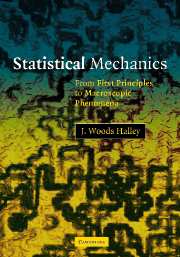Introduction
Published online by Cambridge University Press: 05 June 2012
Summary
The problems of statistical mechanics are those which involve systems with a larger number of degrees of freedom than we can conveniently follow explicitly in experiment, theory or simulation. The number of degrees of freedom which can be followed explicitly in simulations has been changing very rapidly as computers and algorithms improve. However, it is important to note that, even if computers continue to improve at their present rate, characterized by Moore's “law,” scientists will not be able to use them for a very long time to predict many properties of nature by direct simulation of the fundamental microscopic laws of physics. This point is important enough to emphasize.
Suppose that, T years from the present, a calculation requiring computation time t0 at present will require computation time t(T) = t02−T/2 (Moore's “law,” see Figure 1). Currently, state of the art numerical solutions of the Schrödinger equation for a few hundred atoms can be carried out fast enough so that the motion of these atoms can be followed long enough to obtain thermodynamic properties. This is adequate if one wishes to predict properties of simple homogeneous gases, liquids or solids from first principles (as we will be discussing later). However, for many problems of current interest, one is interested in entities in which many more atoms need to be studied in order to obtain predictions of properties at the macroscopic level of a centimeter or more.
- Type
- Chapter
- Information
- Statistical MechanicsFrom First Principles to Macroscopic Phenomena, pp. 1 - 4Publisher: Cambridge University PressPrint publication year: 2006



